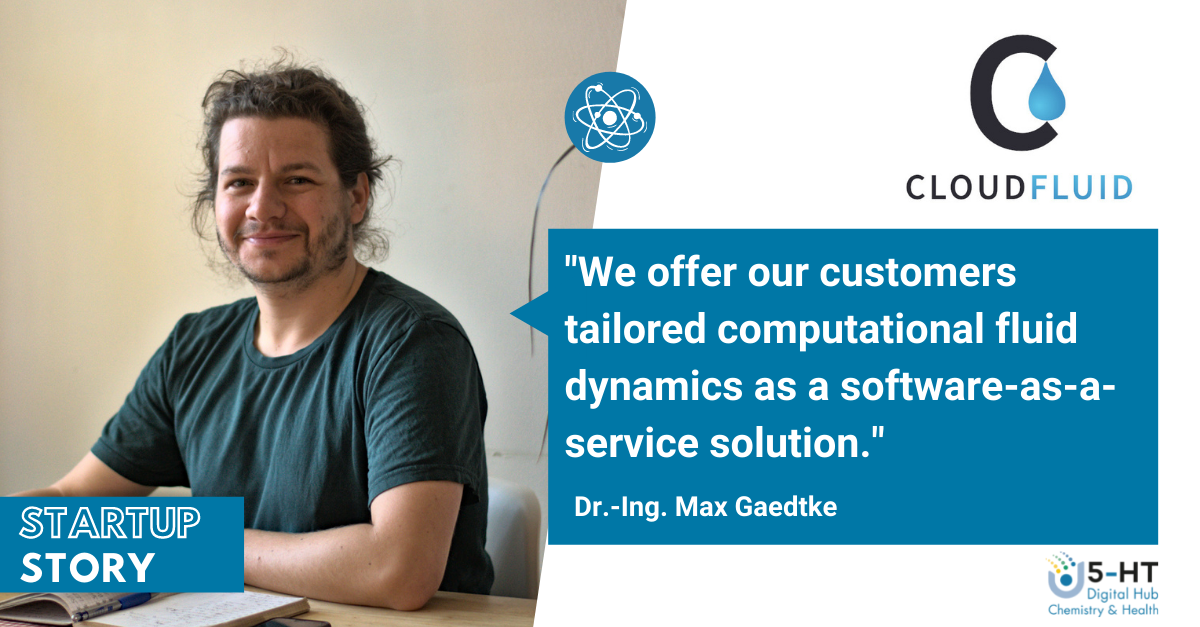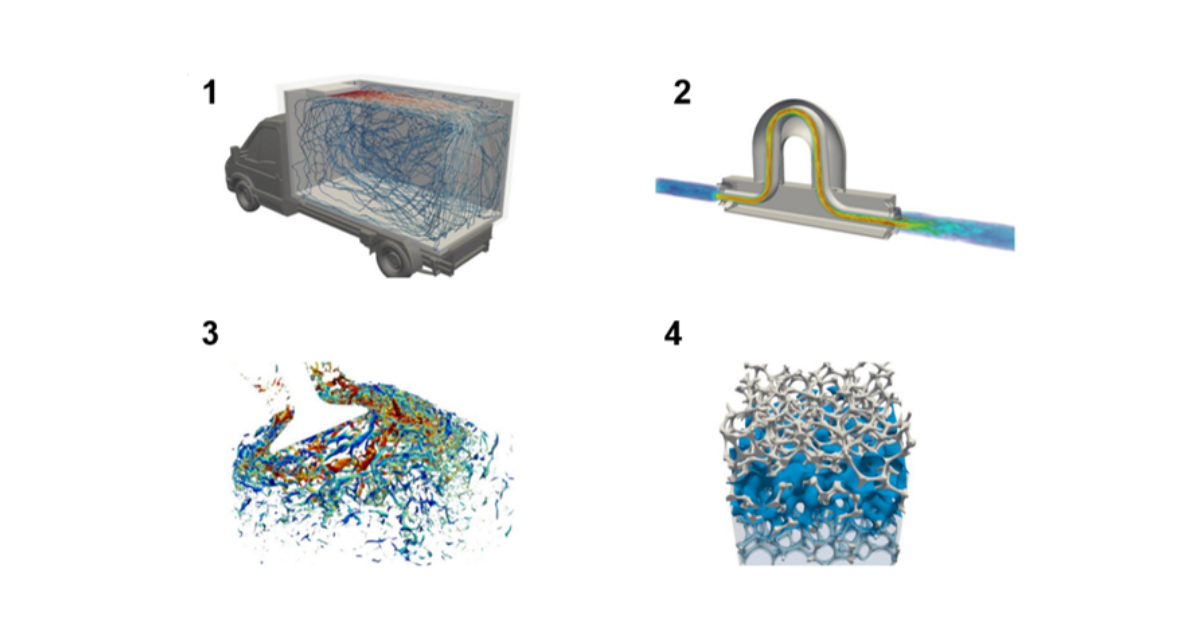Rethinking flow simulations with cloudfluid
Katharina Kittelberger
Where do wind turbines generate the maximum amount of electricity? How should computers be flown through so they don't overheat? And how can hydrogen safely enter a compact storage facility? All these challenges have two aspects in common: They deal with fluid flows and they can be solved with simulations from cloudfluid. cloudfluid, a high-tech startup founded in 2021, has developed a completely new way to approach computational fluid dynamics (CFD) simulations and offers them to its customers as a tailored software-as-a-service solution.
Regarding the areas of application, Managing Director Dr.-Ing. Max Gaedtke emphasizes: "There are numerous cases where flow phenomena occur that are often not accessible at all or only with difficulty using measurement technology. If you want to know what you should be doing here, what effects certain design decisions have, or if you want to optimize, then it's helpful to use our simulations."
In an interview with 5-HT, Max gives us exciting insights into the beginnings of the young startup and explains how their technology is being used in the chemical and healthcare industries in addition to mechanical and process engineering.
 Dr.-Ing. Max Gaedtke, Managing Director at cloudfluid
Dr.-Ing. Max Gaedtke, Managing Director at cloudfluid Conventional flow simulations as an obstacle course
The motivation for the founding of cloudfluid was the identification of three obstacles that have so far limited the widespread use of flow simulations, especially for small and medium-sized enterprises: "Turbulence is one of the most difficult physical problems, and accordingly the software tools for fluid dynamics simulations are highly complex. That's why an engineer is usually needed who is specialized in the particular software, including the algorithms that run in the background. This is the only way to ensure that the results are of the desired quality and reliable.
In addition, large software packages usually entail inflexible annual licenses," Max explains.
Our goal is to show that simulations provide deep insights. At the same time, we don't want to steer anyone into inflexible licensing agreements that also bring financial obstacles.
Third, computational capacity is problematic in previous fluid dynamics simulations because the more precise results are to be, the higher the resolution of the computational domain must be chosen. This leads to long simulation times and means higher costs for the customer, which Max describes with the simple formula "computing time = money." In some cases, the problems are simply so complex that they cannot be calculated economically with the available hardware.
cloudfluid overcomes these obstacles. How exactly do you do that?
"The customer doesn't need to buy expensive hardware - the calculations take place in the cloud. The customer only pays for what he actually uses. We consistently avoid inflexible license agreements or hardware investments. We rely on a flexible pay-per-use concept," Max explains. "With our combination of customized smart clients and flow solvers in the cloud, we provide our customers with fluid dynamics analyses faster and easier than before."
cloudfluid, unlike traditional CFD software providers, does not provide a "one-fits-all" software interface. Such solutions often impede customers more than they benefit, as they must choose from a variety of models and associated parameters - and the necessary expertise must first be acquired. This can be a lengthy, error-prone and expensive process.
With our toolbox of implementation variants, we individually assemble the fluid flow models to create the best compromise of runtime, precision and computational cost for the customer.
In the process, the customer approaches its successful simulation model in three steps: First, the specific use case is analyzed in a kick-off meeting. "This addresses exactly how fluid dynamics simulations can help the customer develop better products," Max says.
In the further course, cloudfluid develops and implements a multiphysics model based on the Lattice Boltzmann method, which is tailored to the specific use case and can solve the corresponding engineering problem. The advantages of the Lattice Boltzmann Method are, among many others, the automated meshing of the computational domain and the very performant time-resolved simulation of even complex turbulent flows - the cloudfluid solver has already proven to be more than 250 times faster than a coventional solver in a preliminary study.
In the third step, cloudfluid designs a graphical user interface based on the customer's individual needs, which the customer can then use to run simulations by himself independently.
 Potential application examples of cloudfluid flow simulation software: 1. conjugate heat transfer (CHT), 2. fluid-structure interaction (FSI), 3. large eddy simulation (LES), 4. phase change at the pore scale (view source)
Potential application examples of cloudfluid flow simulation software: 1. conjugate heat transfer (CHT), 2. fluid-structure interaction (FSI), 3. large eddy simulation (LES), 4. phase change at the pore scale (view source) Who are both current and potential cloudfluid customers?
"The areas of application for our technology are enormously diverse. Our customers are correspondingly diverse," Max explains, "because in general, knowledge from numerical fluid simulation can be used to drive developments of more efficient products in many different areas. Concrete examples are more efficient batteries through optimized cooling, cleaner water through optimized high-efficiency filters, more efficient manufacturing processes through optimized stirred tanks, or higher yields through optimized reactors."
To summarize, it is clear that the cloudfluid solution, thanks to flexible billing, highly efficient hardware in the cloud and modern algorithms, is particularly interesting for companies for which investments in expensive software licenses and large computing capacities are not economical.
Additional advantages from the customized fluid solver:
Through an efficient implementation on high-performance graphics cards (GPUs), cloudfluid not only performs extremely fast calculations, but also fully automates the processes. "This way, the acceleration of calculations by a factor of more than 250 can be achieved. That enables the use of more precise, multiphysics models that previously required large investments in computing capacity using conventional methods.
The Smart Clients are also specifically tailored to the customer's fluid problem, so they can be operated without any CFD expertise, while the quality of the results is guaranteed by our pre-selection of models and automatic optimization of numerical parameters. This makes the smart clients highly attractive, especially for long-term use."
As a result, cloudfluid's simulations deliver real added value, enabling customers to drive rapid and digital development of their products without physical prototypes and with fewer experiments. "In addition to precisely capturing experimentally inaccessible parameters, physical effects can also be looked at in isolation," says Max.
cloudfluid reviews a successful year and looks forward to the ones to come
"With our solver and associated workflow up and running, we have now moved from the proof-of-concept to the proof-of-value phase. In addition to our current pilot customers, we have had a number of promising discussions with other interested clients. The goal is to convince even more companies of the benefits of our business model."
In the next 1 ½ years, we would like to successfully complete the "proof-of-value" phase to subsequently build up a customer base that sees cooperation in their mutual interest.
For the time being, cloudfluid is starting to implement its business idea in Germany. But because the model is highly scalable, a potential European or global scaling is imaginable. "We have already been able to win a large cloud provider as a cooperation partner. This partner can provide us with computing power on GPUs worldwide. Accordingly, we can meet the demand when it comes," he emphasizes.
Opportunities in the health sector through cooperation with 5-HT
"In addition to the possible applications in the chemical industry already mentioned, the healthcare industry also provides some potentially very interesting use cases for flow simulations - not only in medical technology but also in human medicine. In digital medicine, there is an ever-sharper focus on individual disease patterns. For example, if a patient suffers from arterial stenosis, our technology can potentially help to evaluate a suitable stent for this very patient."
This example illustrates well how complex research on living organisms is in general, as experiments here involve a lot of effort. cloudfluid can simplify these by developing three-dimensional "digital twins" of human organs together with imaging methodology: "Consequently, in the future we will be able to supplement the image of a heart, lung or artery with flow data, for example. With the blood flow simulated, it will be possible to analyze which treatment would be most suitable for the patient in question even before an operation - which will simultaneously lead to greater safety in treatment methods," Max summarizes.
Finally, he adds, "We've seen that there are some healthcare and chemical companies in your network for which our technology may be of interest. It would be great if we could get contacts with these same companies through 5-HT."
Picture spurce:
- Gaedtke, M., Wachter, S., Raedle, M., Nirschl, H., & Krause, M. J. (2018). Application of a lattice Boltzmann method combined with a Smagorinsky turbulence model to spatially resolved heat flux inside a refrigerated vehicle. Computers & Mathematics with Applications, 76(10), 2315-2329.
- Haussmann, M., Reinshaus, P., Simonis, S., Nirschl, H., & Krause, M. J. (2021). Fluid–Structure Interaction Simulation of a Coriolis Mass Flowmeter Using a Lattice Boltzmann Method. Fluids, 6(4), 167.
- Haussmann, M., Ries, F., Jeppener-Haltenhoff, J. B., Li, Y., Schmidt, M., Welch, C., ... & Sadiki, A. (2020). Evaluation of a near-wall-modeled large eddy lattice Boltzmann method for the analysis of complex flows relevant to ic engines. Computation, 8(2), 43.
- Gaedtke, M., Abishek, S., Mead-Hunter, R., King, A. J., Mullins, B. J., Nirschl, H., & Krause, M. J. (2020). Total enthalpy-based lattice Boltzmann simulations of melting in paraffin/metal foam composite phase change materials. International Journal of Heat and Mass Transfer, 155, 119870.
5-HT Chemistry & Health Newsletter
Want the latest tech and industry news, events, relevant info from the ecosystem and more?
Subscribe to 5-HT Newsletter now Subscribe to 5-HT Newsletter now
Become part of the 5-HT Chemistry & Health
Exchange ideas with innovative startups and future-oriented companies in our ecosystem. We look forward to meeting you!